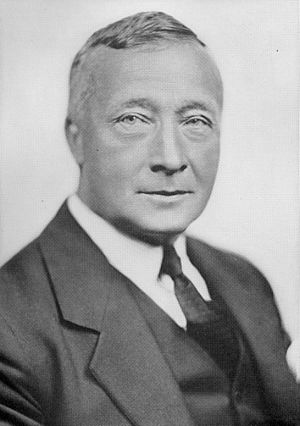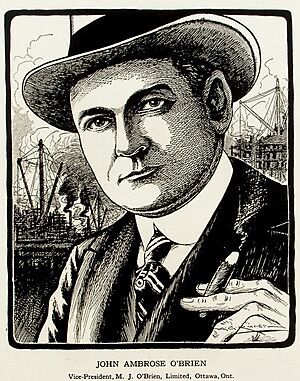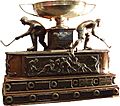National Hockey Association facts for kids
| Sport | Ice hockey |
|---|---|
| Founded | December 2, 1909 |
| Founder | Ambrose O'Brien |
| Inaugural season | 1910 |
| Ceased | December 11, 1918 |
| No. of teams | 11 |
| Country | Canada |
| Last champion(s) |
Montreal Canadiens |
| Most titles | Montreal Canadiens (2), Ottawa Senators (2), Quebec Bulldogs (2) |
The National Hockey Association (NHA) was an early professional ice hockey league in Canada. It had teams in Ontario and Quebec. The NHA was the direct ancestor of today's National Hockey League (NHL). Many of the rules and ways of doing business in the NHL today came from the NHA.
Ambrose O'Brien started the NHA in 1909. In 1911, the league changed the game to "six-man hockey" by removing the "rover" player position. During its time, the NHA faced challenges like competing with another league, the Pacific Coast Hockey Association (PCHA), for players. Many players also left to fight in World War I. There were also big disagreements between the team owners. These problems led to the NHA stopping its operations in 1917. The other team owners wanted to get rid of one owner, Eddie Livingstone.
So, the remaining NHA team owners created the NHL as a temporary league. They wanted to keep playing hockey while they sorted things out with Livingstone. A year later, they decided to permanently close the NHA. The NHL then took over the NHA's rules, constitution, and even its trophies.
Contents
History of the NHA
How the NHA Started
In November 1909, a major hockey league called the Eastern Canada Hockey Association (ECHA) had a problem. The Montreal Wanderers team was bought by a new owner who wanted them to play in a smaller rink. This meant visiting teams would earn less money. Because of this, the other teams in the ECHA broke away and formed a new league called the Canadian Hockey Association (CHA). They did not include the Wanderers.
At the same time, Ambrose O'Brien from Renfrew, Ontario, wanted his team, the Renfrew Creamery Kings, to join a big league so they could play for the Stanley Cup. But the CHA rejected his team. O'Brien met Jimmy Gardner of the Wanderers, who had also been left out of the CHA. They decided to start their own league, the National Hockey Association (NHA). With two other teams O'Brien owned, the NHA officially began on December 2, 1909.
To make the league more exciting and attract French-speaking fans in Montreal, O'Brien and Gardner decided to create a team just for French-speaking players. This team was called 'Les Canadiens', and today they are known as the Montreal Canadiens. O'Brien owned this team at first, planning to sell it to French-Canadian owners later. In total, Ambrose O'Brien and his father were funding four teams in the new NHA.
The O'Briens really wanted to win the Stanley Cup. This led to teams offering huge amounts of money to players. For example, Frank and Lester Patrick each signed with the Renfrew Millionaires for $3,000. Star player Cyclone Taylor reportedly signed for $5,000 per season. These were the highest salaries at the time!
The CHA league didn't attract many fans. So, in January 1910, the NHA decided to invite the Ottawa Senators and the Montreal Shamrocks to join. The CHA then closed down. The NHA threw out all the games played before January 15 and started the season again with seven teams. Even with all of O'Brien's efforts, the Montreal Wanderers won the first NHA championship and the Stanley Cup. This was their only NHA championship.
NHA Growth and New Rules (1910–1914)
In November 1910, the NHA owners created new rules to make the league more professional. They introduced a standard player contract and a salary limit of $5,000 per team. They also created a "reserve clause," which meant teams could keep the rights to ten players, preventing them from joining other clubs. These rules were similar to those used in American baseball and would later be adopted by the NHL. The league even changed its name slightly to allow teams from the United States to join in the future.
The 1910 off-season brought changes to the teams. Cobalt, Haileybury, and Shamrocks left the league. The Montreal Canadiens team was taken over by George Kennedy. The Quebec Bulldogs joined the league for the 1910–11 season. The NHA planned to add two Toronto teams later, once a new arena was built there.
The 1910–1911 season almost didn't happen because players were unhappy with the low salaries due to the new salary cap. They even thought about forming their own league. But since the NHA controlled all the arenas, the players eventually agreed to play. The new rules helped teams make more money. Ottawa won the championship and defended the Stanley Cup.
In 1911, Ambrose O'Brien left the hockey business, and his Renfrew team left the league. The NHA itself became an official corporation. For the 1911-12 season, the league made a big change: they removed the "rover" position, making it six-man hockey. Other leagues still played with seven players for many more years. The NHA played with only four teams that season.
At the same time, the Patrick brothers built two arenas in British Columbia and started the Pacific Coast Hockey Association (PCHA). The PCHA started offering better pay to NHA players, trying to steal them away. Even with this, the Quebec Bulldogs won the NHA championship and their first Stanley Cup.
In 1912–13, two new Toronto teams, the Torontos (later called the 'Blueshirts') and the Tecumsehs, joined the NHA, expanding the league to six teams. Even though the PCHA took some of Quebec's best players, Quebec still won the championship again. That year, the Quebec team traveled west to play the PCHA champions, the Victoria Aristocrats. This was the first time the champions of the two leagues played each other.
In 1913, the NHA and PCHA made an agreement to stop fighting over players. They divided Canada into East and West, and each league agreed to respect the other's player contracts. They also agreed to have a yearly series between their champions for the Stanley Cup. The NHA also added an "option clause" to player contracts, meaning teams had the first chance to re-sign a player after their contract ended.
The 1913–14 season was the last before World War I. The Torontos and Canadiens tied for first place, leading to the NHA's first playoff series. Toronto won and became the first Toronto team to win the Stanley Cup. After the playoffs, the PCHA champion Victoria team came East to play Toronto. Toronto won that series too.
Starting in the 1914–1915 season, the Stanley Cup was always awarded to the winner of a playoff between the NHA and PCHA champions. The Ottawa Senators won the NHA championship that year but lost the Stanley Cup to the Vancouver Millionaires. The next year, the Montreal Canadiens won the NHA championship and then won the Stanley Cup against the Portland Rosebuds, who were the PCHA champions.
World War I and the End of the NHA (1915–1917)
When World War I began, many players left to join the military. By 1915, the NHA didn't have enough good players. Also, the PCHA was still trying to steal players, and there were growing problems among the NHA owners. Two groups of owners formed: one from Toronto and Quebec City, and another from Montreal and Ottawa.
Before the 1915–16 season, Eddie Livingstone, who owned the Toronto Shamrocks, made some moves that angered both the NHA and the PCHA. He tried to hide players from the PCHA draft and bought another Toronto team, the Blueshirts, without league permission. This left his Shamrocks team with no players. The league told Livingstone to sell his Shamrocks team, but he couldn't. The 1915–16 season was played with only five teams, which meant one team didn't play each week. This reduced how much money the owners made and made them very angry.
In 1916, the league took away Livingstone's Shamrocks team. They created a new team in Toronto for the 1916–17 season made up of hockey players who had joined the military. This team, called the 228th Battalion, was very popular. But in February 1917, the regiment was ordered overseas, and the team had to leave the league. This left the NHA with only five teams again.
Instead of continuing with five teams, the league also suspended Livingstone's Blueshirts team and spread its players among the other clubs. This left only four teams. Livingstone threatened to sue the league, which made the other owners even angrier. The league then demanded that Livingstone sell his Toronto team. Instead, he sued the NHA.
The owners of the Canadiens, Wanderers, Senators, and Bulldogs wanted nothing to do with Livingstone. But they found out the NHA rules didn't allow them to simply kick him out. So, on November 22, 1917, the four owners decided to temporarily stop the NHA's operations. Two weeks later, these four clubs started the National Hockey League (NHL). This allowed them to continue playing professional hockey without Livingstone. Every owner except Livingstone was given a team in the NHL, and the NHA player contracts were moved over. The NHL also kept the same rules and season format as the NHA.
The Quebec Bulldogs, however, said they didn't have enough money to put a team on the ice for the NHL's first season. The NHL wanted to have a team from Canada's second-largest city, so they gave a temporary team to the Toronto Arena Company. This company leased Livingstone's Blueshirts players. This temporary team eventually became today's Toronto Maple Leafs.
The NHA didn't disappear right away. The owners had a lawsuit against the military team for leaving the league, and this case still needed to be heard in court. The NHL could operate in the meantime.

The NHA officials met almost a year later, on September 20, 1918. They voted to permanently stop operations, even though Livingstone objected. That fall, Livingstone tried to start a rival league, but it didn't work. Livingstone called a final meeting of the NHA owners on December 11, 1918. The NHL owners attended this meeting. The meeting ended without a resolution, and the NHL season began as planned. The NHA organization itself wasn't officially dissolved for several more years.
NHA's Lasting Impact
The NHA was very creative for its time. It brought in several new ideas that changed hockey. These included:
- Dividing each game into three periods.
- Removing the "rover" player position, making it six-man hockey.
- Introducing "match penalties" for serious rule breaking.
- Allowing players to change lines (groups of players on the ice) during play.
On the business side, the NHA introduced:
- The standard player contract.
- "Reserve clauses" that kept players with their teams.
- A "waiver draft" system for players.
- The first salary cap, limiting how much teams could spend on players.
The NHA is often said to be the first league to use jersey numbers. Players had to wear numbered armbands starting in the 1911–12 season.
The NHA's championship trophy was the O'Brien Cup, a beautiful silver cup donated by the O'Brien family. The NHL continued to use this trophy until 1926. After that, the Stanley Cup became the NHL's main championship trophy. The O'Brien Cup was then awarded annually as another NHL trophy until 1950.
Three current NHL teams have roots in the NHA: the Canadiens, Maple Leafs, and Senators. The Montreal Canadiens recognize their NHA history and records. The Toronto Maple Leafs, however, do not claim the history of the NHA's Toronto Blueshirts, which means they don't count an extra Stanley Cup win from that time. The original Ottawa Senators continued in the NHL after the NHA closed but stopped playing in 1935. A new Ottawa Senators team joined the NHL in 1992. This new club honors the history of the original Ottawa team, which dates back to the 1880s.
NHA Teams and Champions
Season by Season Record
| Season | Teams | Champion |
|---|---|---|
| 1910 | Cobalt Silver Kings, Haileybury Comets, Montreal Canadiens, Montreal Shamrocks, Montreal Wanderers, Ottawa Senators†, Renfrew Creamery Kings | Montreal Wanderers† |
| 1910–11 | Montreal Canadiens, Montreal Wanderers, Ottawa Senators, Quebec Bulldogs, Renfrew Creamery Kings | Ottawa Senators† |
| 1911–12 | Montreal Canadiens, Montreal Wanderers, Ottawa Senators, Quebec Bulldogs | Quebec Bulldogs† |
| 1912–13 | Montreal Canadiens, Montreal Wanderers, Ottawa Senators, Quebec Bulldogs, Toronto, Toronto Tecumsehs | Quebec Bulldogs† |
| 1913–14 | Montreal Canadiens, Montreal Wanderers, Ottawa Senators, Quebec Bulldogs, Toronto, Toronto Ontarios | Toronto† (won playoff over Canadiens) |
| 1914–15 | Montreal Canadiens, Montreal Wanderers, Ottawa Senators, Quebec Bulldogs, Toronto, Toronto Shamrocks | Ottawa Senators (won playoff over Wanderers) |
| 1915–16 | Montreal Canadiens, Montreal Wanderers, Ottawa Senators, Quebec Bulldogs, Toronto | Montreal Canadiens† |
| 1916–17 | Montreal Canadiens, Montreal Wanderers, Ottawa Senators, Quebec Bulldogs, Toronto*, Toronto 228th Battalion* | Montreal Canadiens (won playoff over Ottawa) |
† Stanley Cup Champions. In 1910, both the Wanderers and Senators are considered champions.
- The 228th Battalion team was from North Bay, Ontario, and had to leave the league during the season. The Toronto team was suspended by the league after the first half of the season.
Team History
| Team | Years | Origin |
|---|---|---|
| Cobalt Silver Kings | 1909–10 | Joined from another league (TPHL), then returned to it. |
| Haileybury Comets | 1909–10 | Joined from another league (TPHL), then returned to it. |
| Les Canadiens/Montreal Canadiens | 1909–1917 | A new team, first owned by O'Brien, then by George Kennedy. |
| Montreal Shamrocks | 1910 | Joined from the ECHA in January 1910, played for one season. |
| Montreal Wanderers | 1909–1917 | Joined from the ECHA in December 1909. |
| Ottawa Senators | 1910–1917 | Joined from the ECHA in January 1910. |
| Quebec Bulldogs | 1910–1917 | Joined from the ECHA in December 1910. |
| Renfrew Creamery Kings | 1909–1911 | Joined from the Federal League in December 1909, closed in 1911. |
| Toronto, also known as Toronto Blueshirts | 1912–1917 | A new team, its franchise was bought from O'Brien. |
| Toronto Tecumsehs renamed Toronto Ontarios, 1913–1914 renamed Toronto Shamrocks, 1915 |
1912–1916 | A new team, its franchise was bought from O'Brien. It went bankrupt and was sold in 1913, then sold again in 1914. It merged with the Torontos in 1916. |
| Toronto 228th Battalion | 1916–17 | A new team for the 1916–17 season, made up of professional hockey players in the military. It was based in North Bay, Ontario. |
NHA Presidents
| Image | President | Start Year | End Year |
|---|---|---|---|
| Mike Doheny | 1909 | 1910 | |
 |
Emmett Quinn | 1910 | 1916 |
 |
Frank Robinson | 1916 | 1917 |
Frank Robinson resigned in October 1917, but the league voted him in for another term. In his absence, Frank Calder, the league's secretary-treasurer, acted as president.
See also
- 1918–19 NHL season
- List of ice hockey leagues
- List of pre-NHL seasons
- List of Stanley Cup champions
Images for kids




